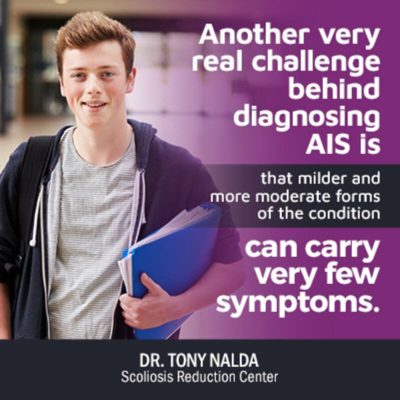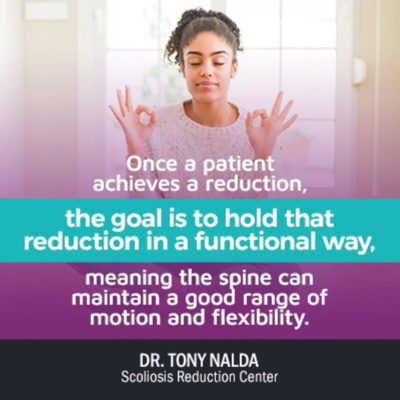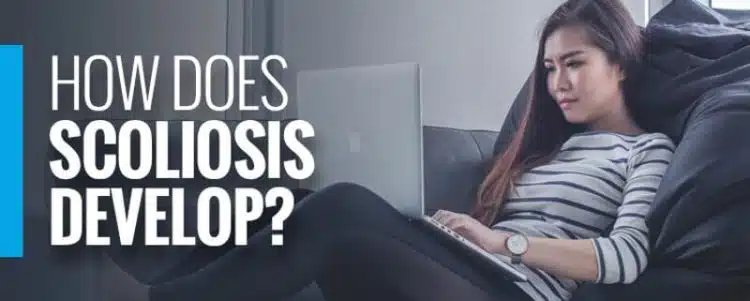How Does Scoliosis Develop?
From a structural standpoint, we know that adverse tension on the spinal cord causes abnormal curvatures to develop as a means of protecting the spine from snapping, but we still don’t understand why that initial tension develops. The simple truth is no one knows just how many degrees a person’s scoliosis will progress; the more relevant question then becomes how to manage the condition’s progression.
Understanding Scoliosis
As the leading spinal deformity among school-aged children in the United States, scoliosis is a lot more common than most people think. Part of the reason I say that is even though the National Scoliosis Center estimates that there are close to 7 million Americans currently living with scoliosis, that estimate only includes known cases that have been diagnosed in the States.
If we were to cast a wider net and find out how many adults and children live with scoliosis worldwide, plus somehow estimate the number of people living with the condition unaware, that number would increase exponentially.
While the word ‘deformity’ sounds extreme and brings to mind images of twisted bodies impossible not to notice, scoliosis develops across a wide spectrum ranging from mild to severe. Symptoms and noticeable changes to the body are different in every case, but in the conditions most common form, Adolescent Idiopathic Scoliosis (AIS), it can be challenging to diagnose.
The Challenge of Diagnosing Scoliosis
Before we explore the different forms of scoliosis and its progression, it’s important to understand why diagnosing the condition can be a challenge, and early diagnosis can have a big impact on progression.
As the nature of progressive conditions is to worsen, early diagnosis is key. It’s much easier to treat a patient’s condition early on before it has progressed to more severe levels, but this is difficult with scoliosis. To better understand, let’s first look at the age group most commonly affected by the condition: adolescents between the ages of 10 and 18.
Adolescent idiopathic scoliosis accounts for 80 percent of known diagnosed cases in the States, and conditions classed as ‘idiopathic’ mean there is no known single cause.
You might be wondering if the mystery surrounding why the condition initially develops is part of why we can’t tell how much a curvature will progress. There’s no denying that scoliosis is a confusing condition, but what we do know is that not fully understanding what causes it doesn’t mean we can’t treat it and manage its progression.
Diagnosing Adolescent Idiopathic Scoliosis
Adolescents between the ages of 10 and 18 represent the largest group affected by scoliosis. When you think of this age group, you likely think of puberty, hormones, cranky teenagers, and secrecy. With this age group, it’s a possibility that they might be inclined to hide changes to their body that could indicate scoliosis.
While there are always exceptions, many adolescents just want to fit in. Things that might set them apart from their peers, like a sudden change in posture or the way they walk, are things they might want to conceal. For those who choose to keep these changes to themselves, they can become very good at hiding them.
Whether we like it or not, there is still a stigma to scoliosis, and adolescents today are under a lot of pressure to have that perfect life, that perfect look, and that perfect body. Social media and advertising have lots of power when it comes to influencing impressionable young minds, and that pressure can make young people feel ashamed of their bodies, especially ones that are developing differently than the norm.
Ways of Hiding Postural Changes
Standing in front of the mirror to practice different ways to stand and walk to counteract changes to gait and posture can be very effective. Wearing black baggy clothes, like hoodies, conceal the back well, especially the upper back.
Denying interest in activities that expose their bodies, like swimming, are additional signs something could be amiss.
For adolescents who notice changes but don’t want to draw attention to themselves or tell their parents, the condition can progress rapidly through growth spurts until the condition becomes more severe and noticeable.
Pain and AIS

Another very real challenge behind diagnosing AIS is that many forms of the condition can carry very few symptoms. While every case is different, in many cases, the condition only causes minor changes to the body that are difficult to spot by anyone other than a specialist trained at what to look for.
When you think of the main issue that brings people into doctor’s offices and emergency rooms, it’s pain. Pain tells us something wrong is happening in the body and is difficult to live with, prompting patients to seek treatment.
While an abnormal spinal curvature sounds like it would be painful, in adolescents who are constantly growing, pain is often a non-issue. This is understood by the absence of compression on the spine.
As the spine of an adolescent is growing and experiencing a lengthening motion, the curvature doesn’t place any extra pressure on the spine and its surrounding nerves and tissues; the opposite can be said for adults with scoliosis.
Staying Ahead of the Curve when Treating Adolescents
When it comes to treating adolescents with scoliosis, the main goal is to stay ahead of the curve and its natural tendency to progress. Through X-rays and visual assessment, we can tell how much a person has grown, how much they are going to grow, and how much their curvature has progressed. What we can’t tell, unfortunately, is exactly how much and how fast a curvature will progress in the future.
What we do know is that only in the infantile phase is it possible for a curvature to correct itself. For other ages, no abnormal curvature will simply correct itself; that’s where the Scoliosis Reduction Center® can help.
Growth is the main known cause of progression, so this age group is most likely to experience rapid progression as they go through the puberty stage. I’ve never treated two patients in the same way, and when it comes to treating AIS, growth is the biggest factor that affects how the condition develops.
Compliance
Some people ask if compliance is an issue when treating adolescents. While scoliosis definitely carries a psychological effect, most of my patients who fully commit to our customized treatment plans see results quickly, and once those first results are seen, the motivation is there to continue the work.
Treatment Goals and Progression
My first treatment goal is structural; I want to treat the patient and their condition to actually achieve a curvature reduction. Through adjustments, scoliosis-specific exercises and stretches, and custom 3-D bracing, our treatment plans are designed to stay one step ahead of a patient’s progression.

The more a patient is progressing, the more we increase treatment-intensity and monitor them closely. If a patient grows an inch, I want X-rays and measurements done to determine if that growth is speeding up progression; if it is, the treatment plan is adjusted to counteract that tendency.
Once a patient achieves a reduction, the goal is to hold that reduction in a functional way, meaning the spine can maintain a good range of motion and flexibility. When an adolescent reaches skeletal maturity, progression rates tend to slow down as growth is no longer a factor, but that’s never exact.
While rates of scoliosis progression have some familiar patterns, there are still a lot of unknowns when it comes to understanding how one person’s condition can develop rapidly, while another patient can progress at a glacial pace.
What we Know About Scoliosis Progression
While there are many unsolved mysteries around how and why scoliosis develops, here’s what we do know:
- The biggest risk factor for progression is growth
- Monitoring the rate of progression is key to successful treatment
- The sooner treatment is started, the more successful it’s likely to be
- Progression in adolescents tends to slow once the point of skeletal maturity is reached
- The larger the curve, the greater the risk for progression
- Older adults experience more rapid progression due to the natural degenerative effects of aging
- Menopause can speed up the progression
- AIS is more prevalent in females
- No one can tell exactly how many degrees a curvature will progress
Different Types of Scoliosis and Progression
Now that we’ve explored progression in the condition’s most common form, let’s take a look at the condition’s less-common types. While 80 percent of diagnosed scoliosis cases are idiopathic, the remaining 20 percent have known causes.
Congenital Scoliosis
Congenital scoliosis is caused by a bone malformation that’s present at birth. Known to develop in the first six weeks of gestation, this anomaly is best described as the result of a misformed vertebra. If you picture a healthy spine as bricks stacked on top of one another separated by discs, in congenital scoliosis, one of those bricks is shaped like a triangle, causing the spine to shift and become misaligned.
When it comes to progression with congenital scoliosis, growth is still a big factor. As the most rapid stage of spinal growth is up to age 5 and during the adolescent phase, these are the times that progression is most likely to occur and needs to be monitored closely.
Neuromuscular Scoliosis
Neuromuscular scoliosis is caused by diseases like muscular dystrophy and cerebral palsy that affect the spine and can lead to an abnormal spinal curvature. This form of scoliosis develops as a secondary complication to larger medical issues caused by disorders of the spinal cord, brain, and muscular system.
Patients with neuromuscular scoliosis are much more likely to experience rapid curvature progression that will continue into adulthood. Progression severity is connected to the level of neuromuscular involvement.
Traumatic Scoliosis
Traumatic scoliosis is caused by a trauma to the spine, such as in a fall or car accident. With approximately 50,000 Americans experiencing spinal column fractures yearly, most unstable spinal injuries are recognized and treated early.
In many cases of traumatic scoliosis, surgical intervention is considered as the answer to progression.
Degenerative Scoliosis
Degenerative scoliosis is caused by spinal disc degeneration. The spinal discs sit in between each vertebra that make up the spinal column; they act as shock absorbers, tough ligaments that hold the vertebrae together, and cartilaginous joints that help facilitate the spine’s mobility.
When the discs start to degenerate with age, most common after age 50, they can sometimes degenerate more on one side of the spine, resulting in the curvature development characteristic of scoliosis. If the curvature’s Cobb angle measurement is 10 degrees or more, it’s considered scoliosis.
When it comes to these less-common forms of the condition, the scoliosis most often develops as a secondary complication to a more prevalent medical condition or issue. While we know the initial cause behind the scoliosis developing, once that curvature is there, other than growth, there are still a lot of unknown factors that come into play with determining its progression.
Conclusion
While we understand curvature development as the result of tension on the spine and its attempt to protect itself, we still don’t understand where that initial tension comes from, and in most cases, no one can tell how that curvature is going to progress.
In 80 percent of scoliosis cases, the cause is unknown; in the remaining 20 percent, causes are known and progression varies from one form of the condition to the next and from patient to patient.
When considering the condition’s most common form, AIS, the challenge to staying ahead of its progression stem from the initial difficulties of diagnosing the condition early on. In most cases, adolescents come to me after their condition has progressed to a certain degree; this is because AIS can carry few visible symptoms, and in some cases, adolescents who do notice bodily changes could conceal them out of embarrassment.
While early diagnosis and treatment increase the likelihood of success, it’s never too late to start treatment, and here at the Scoliosis Reduction Center®, we’ve achieved reductions with multiple forms of the condition and every age group.





